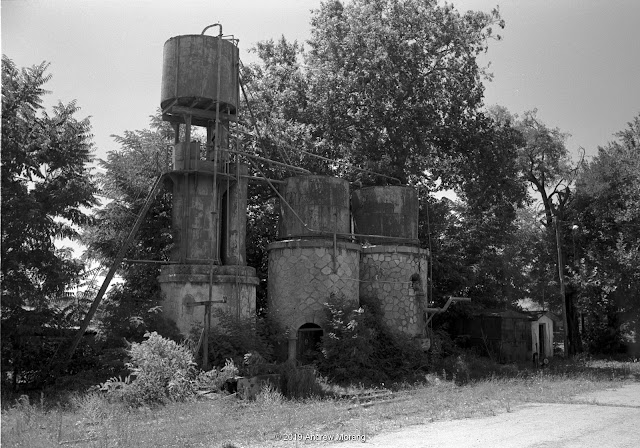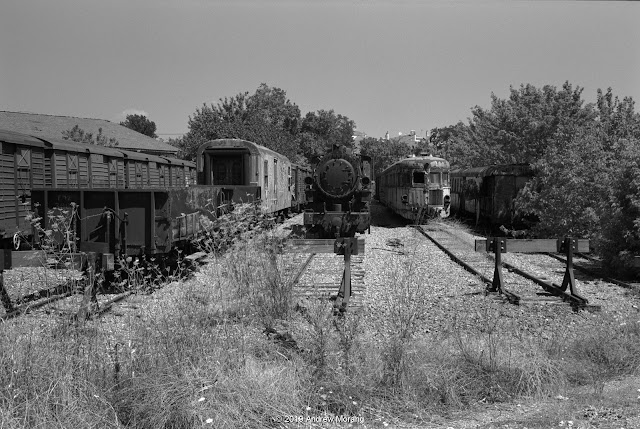The Piraeus, Athens and Peloponnese Railways (known as S.P.A.P., or in French, the
Chemin de fer du Pirée-Athènes-Peloponése) was founded in 1882. It owned and operated the 1 m (3 ft 3⅜ in) (metre gauge) railway system connecting Piraeus and Athens to various destinations in the Peloponnese region of Greece.
 |
| Peloponnese system map, from poster in rail museum in Diakofto |
Service on the 1-m system was abruptly discontinued in 2011 during the Greek economic crisis. Small towns in the central Peloponnese were abruptly left without train service. My family and I were fortunate to take the old train in
1997 from Kato Achaia to Athens. It was slow and rather smelly, a throwback to an earlier era.
Currently, the Athens Suburban Railroad runs from the Eleftherios Venizelos International Airport (ATH) through the northern suburbs of Athens, across the Corinth Canal, and as far west as the town of Kiato. This full gauge rail system is being extended to the western seaport of Patras. In mainland Greece, the new rails use a different right-of-way, but along the narrow Peloponnese coastal plain facing the Gulf of Corinth, the new tracks have buried many stretches of the old single-track line.
During my 2019 visit to Greece, I tried to follow the old 1-m line and see how many railroad stations and work buildings were still standing. In
2011 and
2018, I photographed the railroad station in Corinth, so there was no need to revisit. For this survey, I started further west, near the town of Nerantza, and drove west along the coast.
This was a workshop or possibly a small station near the town of Nerantza. In 2005, the 1-m track was still in regular use and I was lucky to photograph a diesel work car chugging along the line. In 2019, the building was still standing and still intact, but slowly being covered with vines.
In the main town of Xilokastro, I could not find a depot or rail yard. But further west, in the little resort town of Lycoporia, I stumbled on the former depot. It was clean and well-painted.
 |
| Diakofto rail yard, 1998 (Kodak Panatomic-X film, Leica M3 camera, 20mm ƒ/5.6 Russar lens) |
 |
| Workshops at Diakofto, Greece |
 |
| Unused water tower for steam locomotives, Diakofto, Greece |
The town of Diakofto (Greek: Διακοπτό) is the lower terminus of the popular
Diakofto–Kalavryta Railway, an 1880s 750 mm gauge Abt rack system that threads the dramatic Voraikos Gorge and ends at the mountain town of Kalavryta. I wrote about the ride in
2012. The 1950s or 1960s-vintage depot is still in use for the 750 mm tourist train, but much of the rail yard has been dug up and rebuilt to accommodate the new full-gauge railroad.
 |
| 750mm gauge steam locomotive, mgf. by Cail in 1891, in poor condition, Diakofto, Greece |
 |
| Workshops with 2009-vintage diesel electric Stadler Rail cars on the left and 1960s Deaucaville trainsets on the right |
One traditional stone workshed at Diakofto was clean and fresh. I found neat little workshops or storage sheds like this throughout the system. Many were freshly maintained before the system shutdown in 2011.
A few miles west of Diakofto, I tried to trace the rail line using Google maps. At the town of Elaion, I found the old depot, but the tracks and bed were completely gone. A dirt road that had once been the railroad right-of-way went off to the west, but it was not suitable for a sedan.
Elaion was my westward limit on this excursion. Below a photograph of the former Patras rail station in 1997, when the 1-meter system was still in use. The station was a bit grungy but active. I have not been there recently.
 |
| Patras railroad station, 1997 (Kodak Tri-X Professional film, Rolleiflex 3.5E with Xenotar lens) |
The 2019 photographs are from Fuji Acros 100 film, which I used in my
Leica M2 camera with 35mm and 50mm ƒ/2 Summicron lenses. I added green or yellow filters on some frames to lighten foliage or enhance the sky. The photograph of the Patras station was from my old Rolleiflex with a 75mm ƒ/3.5 Xenotar lens.
The next post is about the handsome
train station in Tripolis.























































